|
|
review
|
Bipolar Bear
Catherine Kidd
Conundrum Press, 2006
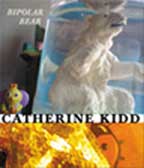 (Book includes a DVD, produced by Taien Ng-Chan with music by DJ Jack Beetz, however, this book was reviewed without the DVD that accompanies it) (Book includes a DVD, produced by Taien Ng-Chan with music by DJ Jack Beetz, however, this book was reviewed without the DVD that accompanies it)
I’ve often wondered if the world would be a better place if some other species ran it. I wonder if they too, after thousands of years of dominance, would remain as insecure about their place in the grand scheme of things as we are. And if they had us as pets, would they walk us on choke chains and argue about whether we have souls? Or would the world be a greener but much less convenient place?
Catherine Kidd’s latest book, Bipolar Bear, is a rich collection of parallel wonderings that defies easy description. It’s certainly bigger on the inside than on the outside, so don’t expect an easy afternoon’s read. You’ll need time to breathe and think and digest. The book contains nine stories/poems, most of which use the animal kingdom and nature as themes, while not necessarily being about them. And it’s peppered with photos of wildlife (alive and stuffed), drawings and scenes from Kidd’s spoken word and theatre performances.
The title story is one of my favourites. Kidd uses words like Play-Doh and her imagery took my breath away:
“But the other day they took a group of human loonies to the zoo, to remind us who we were and who was who… We paced in nervous haste before the cages, or dawdled awkwardly, collectively twiddling opposable thumbs. Feeding clumsy popcorn to ourselves. Consuming eyefuls of animals, like Crackerjack prizes inside.”
You’ll meet many wonderful characters within these pages: penguins, an iguana, polar bears, ex-lovers, fungi, meerkats and more. Often they’ll come to you in a Dr. Seuss-like rhyme—a technique that, despite my fondness for nature’s bounty, I found somewhat tedious. That is, until I realized that what I was really reading was a spoken word script. So I invited the cats to listen while I read out loud—something I daresay we all found rather fun.
But ultimately, the pieces I loved best in the book were more prose than poetry: “Bumpy Passages” (originally published in ascent magazine #26), a story that’s ostensibly about the passing of Bumpy, Kidd’s pet iguana, but is really a meditation on everything and nothing. I also enjoyed “Psitticine Flute,” a story about a bizarre love quadrilateral and lost and found things.
And finally, there’s one incredible piece called “Even Ferret-Breeders Need Better Verbs,” where, for the entire length of the story, the vowels a, i, o and u are given some “vacation time.” You read right – the entire story is made up of words using just the vowel e. I would have wagered a year’s pay that it wasn’t possible, but the narrative isn’t half bad.
But, possibly even more remarkable than her literary gymnastics, is the fact that Kidd manages to keep the ultimate message of the book kind – a message of hope, not a scathing indictment of human carelessness.
This sort of experimentation with animals I thoroughly support!
– Geeta Nadkarniback to top Yoga Nidra
Richard Miller
Sounds True, 2006
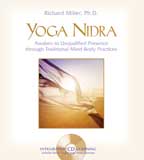 Waking up in my body, the teacher is speaking gently. I don’t quite understand what she says. Her words are creating contrasted images of beauty and ugliness in my head. While trying to scratch my nose, I can feel my arm moving but it never reaches my nose. Words strike my mind like a bell, ideas reverberate into dream. For a moment I lose what is happening. I relax. I can now hear the teacher again. I wonder if I am in the same state I was previously. I try to scratch my nose and once again I can feel the impression of movement in my arm but my body stays still. This fragile state feels like sailing with a small boat in a storm, trying not to fall in the sea of dreams. The only way to keep the boat going is to stay present. Waking up in my body, the teacher is speaking gently. I don’t quite understand what she says. Her words are creating contrasted images of beauty and ugliness in my head. While trying to scratch my nose, I can feel my arm moving but it never reaches my nose. Words strike my mind like a bell, ideas reverberate into dream. For a moment I lose what is happening. I relax. I can now hear the teacher again. I wonder if I am in the same state I was previously. I try to scratch my nose and once again I can feel the impression of movement in my arm but my body stays still. This fragile state feels like sailing with a small boat in a storm, trying not to fall in the sea of dreams. The only way to keep the boat going is to stay present.
This was one of my first experiences with Yoga Nidra practice. As Richard Miller explains in his new book Yoga Nidra, the practice of Yoga Nidra has many layers and uses. It can be practised as a deep relaxation at the end of Hatha practice (Savasana), helping the body and the mind integrate the practice. It can also be used as a complete yoga, a system to discover our true nature.
A student of Advaita Vedanta master Jean Klein, clinical psychology, and many branches of non-dualist traditions including Zen and Kashmir Shaivism, Miller bring us an important work on the ancient tantric teachings of Yoga Nidra.
He uses the Maya Kosha to define the progressive states of awareness in Yoga Nidra. The Maya Koshas are a representation of all the layers of our being: physical, energetic, emotions, thought and symbols, bliss, and the awareness of the “I,” all contained in our true Self. Using this system, Miller invites us through detailed explanations and exercises to explore ourselves: experimenting with the pairs of opposites on every layer, welcoming the sensation and observing the dissolution of our trusted and dear “reality.”
With a clear psychological vision and non-dual heart, Miller blends Western understanding with Eastern wisdom to explore and open up the secrets of Yoga Nidra. Including a practice CD, worksheets and detailed instructions, the book is intelligently made, intuitive and practical. The CD is a beautiful complement to the book, giving you the freedom to experience the teachings before intellectualizing them. The exercises provide proof that the teachings are alive and can benefit from our Western point of view – not only from the technological addition of the practice CD, but also with our modern view of the mind and ease in blending many spiritual paths in order to understand these teachings.
Every morning for the last few weeks I wake up and can feel a slow and progressive disidentification happening. I keep my eyes closed with a strange feeling about my life; it seems to be happening in front of me, without me. Somehow I have nothing to say, I can only observe, peacefully. – Geffroy Tremblayback to top Mantras and Misdemeanours:
Vanessa Walker
Allen & Unwin, 2006
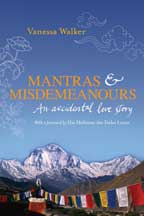 Mantras and Misdemeanours is a journalist’s story of moving to McLeod Ganj in the Himalayas, home to Tibet’s government in exile. An exploration of not only her own spiritual journey, the book includes interviews and conversations with widely known Buddhists, presented in an earthy, human manner. The author explores the different attitudes of Tibetans in exile – from those who believe wholeheartedly in the middle way approach the Dalai Lama has toward the future of Tibet, to the freedom fighters who still want action, as well as the many who are torn between these. Mantras and Misdemeanours is a journalist’s story of moving to McLeod Ganj in the Himalayas, home to Tibet’s government in exile. An exploration of not only her own spiritual journey, the book includes interviews and conversations with widely known Buddhists, presented in an earthy, human manner. The author explores the different attitudes of Tibetans in exile – from those who believe wholeheartedly in the middle way approach the Dalai Lama has toward the future of Tibet, to the freedom fighters who still want action, as well as the many who are torn between these.
Vanessa Walker’s year in India describes vividly the experience of living in North India, from the monkeys who steal her drying underwear, to the frigid cold of concrete apartments in winter with two-day snow storm–caused power cuts (in addition to a general ban on heaters). The author’s personal relationships with first-generation Tibetans in exile are magnified by her blossoming friendship with a former monk. The phenomenon of Western women marrying Tibetan men is described, as well as the outwardly friendly yet seemingly competitive rivalry between the four main Tibetan peoples. Contemporary Tibetan culture comes across as a complete mix – from those following the old traditions to the ways the West has influenced modern culture in the form of globalization. A unique example is the controversy of the Miss Tibet pageant, complete with a disco diva presenter. A realistic impression of modern-day India is transmitted in the writing – the touts chasing the new tourists, the slowness of Indian bureaucracy and encounters with third-world medical facilities.
There is the story of, and interview with, the State Oracle of Tibet; Ngari Rinpoche, the bipolar younger brother of the Dalai Lama; plus a foreword from His Holiness himself. The Dalai Lama eloquently captures the essence of the book, describing it as a fresh look at the Tibetan community, and especially on the concerns of young Tibetans today. Tenzin Palmo shares words of wisdom and inspiration, telling of the history of Tibetan nuns and her work in providing opportunities for them to learn and grow. She also offers inspiring advice that rings true – to work on training the mind in patience and compassion. Ngari Rinpoche shares his experience on being displaced with no sense of belonging. In a general sense, perhaps we can all relate to this, though most of us will not be able to imagine having no security in legal status. However, he points out that without having a country or security, there is plenty of opportunity for spiritual growth. This gives opportunity to reflect on attachment to identity – to nationality, to community, and leads me to ponder the difference between belonging to a group and belonging to the cosmos, and who is the “I” that “belongs”?
Walker says she cannot fulfill her goal of knowing Buddhism through the Tibetan people. Faced with contradictions typical of the human race, all the pairs of opposites are in these people. It is inspiring to note her lost appetite in drawing conclusions. The writing of the book seems to have truly been Walker’s practice of dharma, as advised before her trip by a Divinator Rinpoche – a journey of finding the truth about herself. – Sarah Spenceback to top Grub: Ideas for an Urban Organic Kitchen
Anna Lappé and Bryant Terry
Tarcher/Penguin, 2006
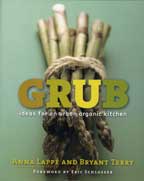 One thing that unites all people is the love and need for food. The trouble is, while we in the West are experts at counting calories and reading nutritional labels, it’s what’s NOT on the label that concerns the writers of Grub: Ideas for an Urban Organic Kitchen. Toxic pesticides, genetically modified ingredients, the fossil fuels used to make and transport the item, the cancer rates in farmers. These statistics do not appear on the label beside the sodium level, yet for many they are just as important. Unlike the old adage, what you don’t know CAN hurt you, and our society is likely to pay a high cost for this period of relatively blissful ignorance of the origins of our food. One thing that unites all people is the love and need for food. The trouble is, while we in the West are experts at counting calories and reading nutritional labels, it’s what’s NOT on the label that concerns the writers of Grub: Ideas for an Urban Organic Kitchen. Toxic pesticides, genetically modified ingredients, the fossil fuels used to make and transport the item, the cancer rates in farmers. These statistics do not appear on the label beside the sodium level, yet for many they are just as important. Unlike the old adage, what you don’t know CAN hurt you, and our society is likely to pay a high cost for this period of relatively blissful ignorance of the origins of our food.
Anna Lappé and Bryant Terry have put together a book that is one part exposé, one part solutions and one part recipe book. The first part, written by Anna Lappé, exposes the dire state of the modern food industry. She includes terrifying statistics about monopolies (80 percent of the commercial grain that we consume globally comes from just four companies) and awful accounts of everyday practices of the biochemical industry behind much of conventional farming. She documents the dramatic disappearance of the small family farm, and even cites suicide as the fifth-largest killer of farmers in the U.S.
The second part of the book talks of the importance of rediscovering what the authors call Grub, i.e. locally grown, seasonal, health-supportive, organic food (which humans ate for millennia until recently). The third section is a set of recipes using Grub proposed by Bryant Terry. He contributes the theme menus for “Grub parties” complete with soundtracks to listen to while cooking and poetry to be read aloud.
I fundamentally agree with Terry’s perspective that there is far too much food dogmatism out there. Too many people are identifying themselves with strict labels (i.e. vegan, ovo-lacto vegetarian, raw foodist, fruitarian…) and feeling we have to strictly maintain our eating rules, not for health reasons or ethics but because we don’t want to be seen as hypocrites. So even though Grub is supposed to be local and vegetarian, his menus include the occasional tropical ingredient or opportunity to substitute meat should your tastes prefer it.
The exposés made me feel disempowered and frustrated by failing to explain how we came to be so ignorant about the origins of our food and workings of the industry that feeds us. It was just too much to absorb all those statistics and still retain the feeling that one can make choices that matter. Like a lot of environmental advocacy, it places our attention on everything that is “wrong” with the world, but then doesn’t offer us an alternative vision in which to park our attention. How would things work in a future society where the food system is equitable and harmonious with nature? We desperately need answers to these questions. What Grub does do, however, is show us how young urbanites can create a revolutionary subculture, one devoted to celebrating self-expression and whole foods cuisine, despite the machinations of the giant food overlords. Which, I suppose, is a way for that change to get started. – Claire Heenan back to top The Yogi’s Joy: Songs of Milarepa
Sangharakshita
windhorse publications, 2006
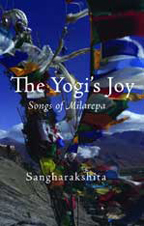
“Milarepa lived in a cave…Occasionally he would meet someone. He would sing songs to them. That’s about it, really.”
Upon first glance, few subjects seem more distant and remote to the contemporary Western reader than the story of a cave-dwelling, ascetic, medieval, Tibetan Buddhist monk. A hermit who possessed little more than a cotton loincloth and a penchant for song, Milarepa lived in a harsh mountain climate, subsisting on tree nettles to such an extent that his skin turned a shade of green. A closer examination, however, reveals that the life and message of Milarepa is very much pertinent to our present day, for the truths revealed in The Yogi’s Joy: Songs of Milarepa, by Sangharakshita, are timeless and eternal – the truths of the dharma itself.
Legend has it that Milarepa wrote 100,000 songs in his lifetime, the majority of which expressed the joy he found in his life of solitude, meditation and spirituality. He dedicated his isolated existence to the pursuit and articulation of this joy, through which he was able to thrive both physically and mentally in an inhospitable environment. In his songs, he stresses that this joy is not something foreign and external. It is always already there in all of us, only needing to be channeled and released.
Milarepa shared these lessons and songs with the scattered visitors to his mountain lair. The book’s most extensive section details a fascinating interaction with a wealthy, noble, warrior/playboy who eventually renounces everything, including himself, to make Milarepa his guru. Through rigorous practice, the young man realizes that authentic happiness and joy can only come through the cultivation of inner virtue and not through outward possessions. This lesson is applicable to anyone intending to follow a similar spiritual pursuit.
Although the book is readable and imparts many important lessons, it is not without its flaws. At no point are any of the songs reproduced in whole. The reader’s interaction is limited to small fragments that are often followed by pages of tangential commentary and personal musings that detract from the overall organization and continuity of the book. This commentary is coloured by the author’s unequivocally positive and idealistic view of Milarepa’s lifestyle, for he seems to lament the fact that we don’t all live as hermits. This view oversimplifies the issue of asceticism, a complicated and ambiguous one in many religious traditions. I am left questioning how one can practise the ideal of compassion for all sentient beings living in complete isolation.
The Yogi’s Joy is best suited toward those already familiar with the basic tenets of Buddhism. For anyone with a minimal background, it is an enjoyable read and may help to reveal a novel expression of Buddha’s teachings. Ultimately, I empathized with Milarepa’s struggles and successes on his path, as I’ve gone through similar experiences on my own journey of connecting my modern existence with one that outwardly seems so distant and remote. – Daniel Goldsmithback to top World Psychedelic Classics Volume 3
- Love's a Real Thing
Various Artists
Luakabop Records, 2006
| click here to listen |  |
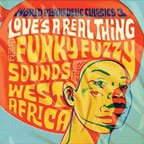 When the flower children of America gathered in Haight-Ashbury to bliss-out on free love and the expanding consciousness of music, West Africa was experiencing its own “Summer of Love.” Influenced by the 1960s counter-culture and music’s new revolutionary technology, West African artists of the 60s and 70s embraced a cross-fertilization of North American psychedelic styles, global flair and their own African indigenous traditions. Songs here nod to pulses of Brit-pop and Northern Soul, the East Coast funk of James Brown and West Coast sounds of Hendrix, as well as Cuban grooves and Latin percussion. Luakabop’s World Psychedelic Classics Volume 3 - Love’s a Real Thing / The Funky Fuzzy Sound of West Africa, offers a kaleidoscope of traditions and innovations. Artists like Manu Dibango and Orchestre Poly-Rythmo reawaken to Africa’s own landscape of sound from the deserts of Cameroon to the idioms of Senegal’s highlife. Bringing back the traditions of soul, funk and groove to Mother Africa, the music on this compilation sounds as globally aware as it does homegrown. When the flower children of America gathered in Haight-Ashbury to bliss-out on free love and the expanding consciousness of music, West Africa was experiencing its own “Summer of Love.” Influenced by the 1960s counter-culture and music’s new revolutionary technology, West African artists of the 60s and 70s embraced a cross-fertilization of North American psychedelic styles, global flair and their own African indigenous traditions. Songs here nod to pulses of Brit-pop and Northern Soul, the East Coast funk of James Brown and West Coast sounds of Hendrix, as well as Cuban grooves and Latin percussion. Luakabop’s World Psychedelic Classics Volume 3 - Love’s a Real Thing / The Funky Fuzzy Sound of West Africa, offers a kaleidoscope of traditions and innovations. Artists like Manu Dibango and Orchestre Poly-Rythmo reawaken to Africa’s own landscape of sound from the deserts of Cameroon to the idioms of Senegal’s highlife. Bringing back the traditions of soul, funk and groove to Mother Africa, the music on this compilation sounds as globally aware as it does homegrown.
With provocative lyrics, heavy bass guitar, shaking maracas, and funk infused keyboards, William Onyeabor in, “Better Change Your Mind,” rouses me into an awakening consciousness of need for global aparigraha, or non-possessiveness, the fifth yama in yogic teachings. “You, America, you ever think this world is yours? You, China, you ever think this world is yours? You, Ca-na-daaa, you ever think this world is yours? My friends, better change your mind.” Onyeabor’s vocals loop with offbeat guitar and keyboards until the heavy bass swallows the music whole into a meditative trance that might, if taken far and long enough, embody a kind of Laja Samadhi, a latent potential of blissful awareness.
“Nevah, Nevah, Nevah do bad,” Ofo the Black Company cry out in a shout for global responsibility on “Allah Wakbarr.” “Love is you, love is me / Brothers! Sisters!” The song calls for a harmony similar to those cries for peace of Curtis Mayfield. A Hendrix acid guitar wails and a congo drum quickens the pace making this African funk anthem a call of global urgency for unity under love. After all, “Love is big, love is real.”
Reaching out beyond narrow nationalism, classics on this collection at the same time comprise the blissful potential of the human heart to move beyond individualism. The music here reminds me I have the potential as a human being to move beyond hate, to reconcile in the love of music and the love for one another. Congo and snare drums, xylophonic tempos and African voices return me to the basic beats and pulses of my own internal rhythms as well, to the heart or anahata nada, the “unstruck” resonance, the inner measure that lies beneath, behind and within all sounds. The Super Eagles sing it well, the music “hold[s] me tenderly,” and proves to me, “a love you can see.” Rhythms embrace me in fine vibrations, reminding me that beyond all conflict, confusion, and separation, “love’s a real ‘ting.” Awakening to the living of love of these songs inspires me to love freely in music, non-possessively in sound, to awaken into an expanding consciousness of the cadences of the human heart beating. – Nancy Miller
back to top The Sun Awakens
Six Organs of Admittance
Drag City, 2006
| click here to listen |  |
 Six Organs of Admittance is the solo project of guitarist Ben Chasny, a player with the ability to summon mystical resonances from the strings of his instrument, who harkens back to fingerpicking masters like John Fahey and Robbie Basho, while incorporating diverse musical elements into his psychedelic folk vision. Cyclical acoustic ragas and low chanted lyrics have always been the centre of Chasny’s sound, and while he has at times taken the role of pop songwriter, other moments find him bent over his instrument in prayer (or maybe just lost in the sound). Six Organs of Admittance is the solo project of guitarist Ben Chasny, a player with the ability to summon mystical resonances from the strings of his instrument, who harkens back to fingerpicking masters like John Fahey and Robbie Basho, while incorporating diverse musical elements into his psychedelic folk vision. Cyclical acoustic ragas and low chanted lyrics have always been the centre of Chasny’s sound, and while he has at times taken the role of pop songwriter, other moments find him bent over his instrument in prayer (or maybe just lost in the sound).
While Six Organs has been prolific, The Sun Awakens is only his second album to be recorded in a studio rather than at home. The first was last year’s School of the Flower, which brought in elements of free jazz, mostly via drummer Chris Corsano, and displayed Chasny’s compositional abilities more fully than his earlier, heavily improvised releases. The Sun Awakens is an equally moving collection that sees Chasny’s sound developing even further and, on the second half, moving into altogether new territories. The introspection and melancholy of early albums Compathia and Dark Noontide are less present here. Rather than inward-focused meditations on the heaviness of being, the perspective here is ecstatic, broad and open.
The first six songs on The Sun Awakens form a consistent suite, bookended by two all-too-brief solo guitar pieces. The first of these solos, “Torn by Wolves,” eases us into the album, a gentle lullaby on electric guitar accompanied by slight cymbal taps courtesy of Noel Von Harmonson, who appears throughout the album. This blends smoothly into “Bless Your Blood,” which continues in the same drifting tempo. Chasny’s trademark buzzing strings are supported by faraway guitar layers and piano until a watery vocal appears somewhere around the two-minute mark, followed by majestic drums and a skyward-reaching falsetto.
“Black Wall” ups the tempo and intensity significantly. Acoustic guitar swirls over ringing chords, but the sound remains tightly controlled, moving forward intentionally before exploding into a burst of lead guitar that ends abruptly. After the concise, cinematic “The Desert Is a Circle,” instrumental “Attar” begins as an acoustic raga and gradually winds up into the most frenzied piece of the collection, blistering guitar winding through circling percussion. “Wolves’ Pup” reprises the opening song as a solo acoustic piece, and the song cycle of the first half of the album draws to a close.
The 24-minute “River of Transfiguration” makes up the second half of The Sun Awakens. Al Cisneros lends a thunderous bass throb, upon which spacious Persian ney flute, tone generators, scattered drums and echoing guitar are slowly layered. A slow, devotional vocal runs through most of the piece, and the whole thing slowly eases into a drift of overtones. If the earlier songs occasionally suggest an ecstatic bursting through to the other side, being set adrift on the “River of Transfiguration” offers a view into the gaping maw of the void. Under the haze of drones and moans, it is carefully crafted and highly vivid. The title says it all, really. – Richard Williamsback to top
|
|